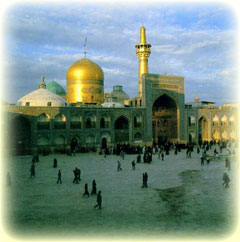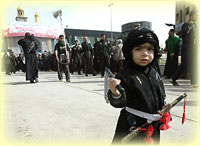|
Iran highlights
Religious Rituals

Life after death has been a major theme with all the religions and the
passage from this life into the other has been dealt with in a variety of ways,
depending on the particular belief system. The major religions of Iran can be
divided into three distinct periods. Pre Zoroastrian or proto Indo- Iranian, Zoroastrian and Islamic period. Around the third millennium B.C., proto-Indo-Iranians had become identifiable by speech as two distinct peoples, the Indians and the Iranians.
The Iranians loaded with their Indo-Iranian traditions were also influenced by the powerful civilizations of the ancient
Mesopotamia. Elements of Sumerian, Babylonian and Elamite belief systems were incorporated into the Iranians ideas of cosmos and life after death. Influenced as such, they believed there was no end for the world or for humans, which were thought to follow one another ceaselessly.
The world after was a continuation of the earthly life with no notions of heaven, hell, reward or punishment. After death the disembodied spirit, the ĎurvanĀE(ravan in modern Persian) lingered on earth for three days before departing downward to a subterranean kingdom of the dead. This place was ruled over by Yima (Sanskrit Yama, Persian Jam/Jamshid in Shahnameh) who had been the first king to rule on earth and the first man to die.
In this kingdom spirits (urvans) lived a shadowy existence, and were dependent on their descendants on earth for survival. Offerings were made to feed and cloth them through rituals at specified times. Most were made during the first year, when the newly departed urvan was assumed to be lonely, and not yet fully accepted into the world of the dead. Offerings would be made by the dead personís heir, usually the eldest son for up to thirty years, the span of a generation.
The first three days right after death were the most important of all. The soul was very susceptible to evil spirits at this time and needed strength and support to make it to the underworld. The soul would have to cross a dark river in a ferry to arrive in the kingdom of dead (Gilgameshís boat ride to reach immortality). This ĎCrossing of the
Separator is called ĎChinvato Peretu Ein the Avestan texts of the later periods.
To help the departed soul, the family would pray, fast and make a blood sacrifice during the first three days. There would be ritual offerings to fire and at the third night deceasedís cloths would be blessed so that the dead person can start the journey fed and clad. Food offerings would be consecrated for thirty days and then once every thirtieth day, till the end of the first year. All together there would be three blood sacrifices at the first year, with annual offerings for the next thirty years.
After the first year the soul was believed to be fully incorporated in the underworld. To sustain the souls of all departed relatives, general offerings were made once a year at the feast of All Souls. In Avesta this is called Hamaspathmaedaya. This feast was celebrated on the last night of the year. They believed the souls would visit their old homes at night and depart at sunset on New Yearís day
Funeral rites involved burial of the dead. Leading members of the family would be buried at the bottom of deep shafts covered by earthen barrows. Ordinary people would be laid in simple graves in the earth. The Zoroastrian word ĎdakhmaĀE comes from this period and means ĎgraveĀE
Sometimes toward the end of the third millennium BC, new ideas are incorporated into the belief system. There is hope that at least some people like the warriors, princes or the priests who have served the gods might escape this eternally joyless existence. If they behave well, do their prayers sacrifices and perform the expected rituals, their souls could join the gods. They would end up in a sunlit Paradise, where all imaginable delights are possible.
ďCrossing of the Separator" becomes a bridge (Chinvat Bridge in Avesta, Sarat Bridge in Quran) with one end resting on the mountain peak of Hara, the other on the road to heaven. Only those worthy of paradise would cross, the rest would fall off and end in the subterranean kingdom of the dead.
With the hope of attaining paradise comes the idea of resurrection. After all, experiencing the joys of heaven in sprit only was not much of a reward! It was assumed that within the first year after death the bones of the dead would be raised up, clothed in immortal flesh and would be unified with the soul in heaven.
The Indian funerary rite to cremation comes from this belief. The mortal flesh was destroyed quickly and the bones would be buried, ready for resurrection. The Iranians, regarding fire as a sacred entity adopted the rite of exposure instead. The corpse would be left in a barren place to be devoured by scavengers. The bones would be collected and buried with offerings and rituals.
With the coming of Zoroaster in the middle of the second millennium BC, major changes are introduced. Humans are created by he Lord of Wisdom (Ahura Mazda) to help other divinities to gradually overcome evil and restore world to its original perfect state. Therefore, the departed soul will be judged on what it has done to aid the cause of goodness.
Attaining paradise becomes possible for all. Women as well as men, priests warriors servants and masters could all go to heaven. Chinvat Bridge becomes a place for moral judgment. People are judged not only on the basis of their offerings, prayers and sacrifices, but also on their ethical achievements.
Mithra presides over the tribunal; accompanied by Sraosha (Soroush) and Rashnu (Eyzad of Justice), who holds the scales of justice. In the Indian Veda the spirits are brought in by two dogs (messengers of Yama / Jam in Persian). In Avesta the two dogs await the spirits at the Chinvat Bridge. Dogs are still venerated by Zoroastrians and if possible are present at their funerals.
Once judged, if the scales are heavier on the good side, the soul is lead by a beautiful maiden, the personification of its own conscience (Ďdaena-E to the paradise. If the scales sink on the bad side, the bridge becomes narrow, sharp and a horrid hag grabs the soul and plunges with it down to hell. The concepts of hell, a place of torment presided over by Angra Mainyu (Ahriman, Shaytan in Koran); heaven, resurrection and individual judgment are Zoroasterís own. These doctrines deeply influenced the later religious developments in the area, i.e. Judo-Christian and Islamic traditions.
 The funerary rites were more or less the same as before. Flesh would be left exposed for a while. Bones would be buried to await judgment day. The old belief survived that the soul lingered on earth for three days after death. Since each personís deeds were responsible for his acceptance or denial into the heaven, the number of rites and observances performed on behalf of the dead by family members was reduced. The funerary rites were more or less the same as before. Flesh would be left exposed for a while. Bones would be buried to await judgment day. The old belief survived that the soul lingered on earth for three days after death. Since each personís deeds were responsible for his acceptance or denial into the heaven, the number of rites and observances performed on behalf of the dead by family members was reduced.
Traditional Zoroastrians today still follow many of the same rites. Unless the death occurs late in the day or at night, the funeral follows in a few hours. At the funeral all dress in white. The shrouded corpse is never touched and simple ablution after the funeral will purify all participants who touch the bier. The White cloths are washed after each funeral. Specific hymns are recited and Avestan prayers are said to pay homage to Soroush. The rite of exposure is still performed if possible.
The processions are normally in complete silence. This is to avoid breaking the power of prayers read to Soroush. Once entering the dakhma the rest of the prayers will be recited in Avestan. The language is assumed to ward off evil spirits. Candles or oil lamps will be lit for three days next to the dead body. Special foods are prepared and no meat is consumed during the first three days. On the third day more rituals are performed, prayers are said, a special cloth (Sedra) is blessed to provide a spirit garment for the departed soul.
Other minor rituals are performed during the first thirty days. The next major ones are on the thirtieth of the month, ĎsirozaĀEand one-year after, ĎsalĀE In between the two ĎrozaĀE recitals of the Farvardin Yasht, the Hymn to All Souls is performed on a regular basis. Crying and other extreme expressions of sorrow are not normally practiced by the traditionalists. They believe such behavior (Mooye in Persian, Amyava in Avesta) belongs to the world of Ahriman and should be avoided.
Muslim conquest of Iran introduced many changes. Quranic concepts of life after death go back to Jewish, and so indirectly, to Persian and ancient Babylonian sources. The world after is a place for judgment, reward or severe punishment. After death, the departed soul will remain in Barzakh (interworld) till Rastakhiz (resurrection). The hour of judgment comes at the end of the world with a mighty blow and blast of trumpets or an angelís summons.
The earth trembles, mountains quiver, the sea overflows its shores; the sun turns on its axis, the moon darkens and split in two. The stars hurtle to earth and the other world is revealed before the eyes of mankind. All humans are resurrected; the Divine Book is opened in which all human deeds are recorded.
Every human receives a list of his/her deeds to read aloud. If the book is placed in the right hand he/she is destined for heaven, if in the left hand, they are doomed to hell. Crossing of the Sarat Bridge will decide their final fate. Blessed ones will cross and end in heaven, for the doomed, the bridge becomes sharp narrow and they drop in hell.
Allah is the ultimate source of power. He is the only creator therefore; he creates both good and evil. Since Shaytan (Satan) himself is a creation of Allah, human life is not about defeating the bad for the sake of the good. It is about submitting to Godís will, following the rules, codes of conduct and performing the prescribed rituals.
For this reason purely ceremonial prescriptions, such as ablutions before prayer, are put on exactly the same level as commandments of an elevated moral value, such as that of honesty. The major sins (Gonahan e kabireh) are not about being evil and do despicable acts. They are about not performing prayers (Namaz), avoiding Roozeh (fasting) or drinking wine. In other words not adhering to Allahís commands.
Ablutions and other rituals such as prayer (Namaz), fasting, pilgrimage to Mecca and paying the religious tax are the primary canonical duty of believers. As a result, many of the rites performed at the time of death are to compensate any shortcomings related to the above acts by the deceased while alive. The relatives ask for Allahís forgiveness of the deceased by reciting prayer of death (Namaz e meyet). Mullahs are paid to perform all prayers that the deceased might have missed and fast for them. All religious taxes owed will have to be paid off.
The body should be buried within 24 hours. It will be washed, scented with Kafoor (used by Zoroastrians as well) and wrapped in a white cloth (Kafan). Since segregation of sexes is a fundamental institution in Islam women are not allowed to participate in the funeral of male relatives (Modern Iranians do not observe the segregation any more). At all times the body and the grave should face Mecca (Ghebleh). The graves should not be marked, since only the almighty himself is worthy of such respects.
The memorial service (Khatm) is on the third day (reminiscent of Zoroastrian tradition). The next major days are one week (Hafteh), forty days (Cheleh) & one year after death (Sal). At all the gatherings participants will be served with special meals. Rich people will give ĎnazryĀE(free food) to poor people. Such acts are regarded as good deeds (Savab) and there is the hope that the act will elevate the deceasedís status in the eyes of God.
Iranian version of Shiite Islam introduced a new dimension into the death rituals. Imam Hussein's fatal journey in Kerbela and Aliís assassination in Kufa have made martyrdom the most important communal ritual. The actual practices were copied and adapted from the Roman Catholic Church by the Safavid kings in the 16th century, but were given a different meaning.
Christian martyrdom is based on the notion of redemption, Christ and the saints were martyred to redeem human sin. Shiite Saints are martyred to guarantee rule by descent from Prophetís blood line (Fatima and her children). Shiites believe in the embodiment of a luminous divine substance in Prophetís family. They are the only true leaders of the Muslim community. The martyrs are supreme heroes who vanquish enemies of the faith with their lives. To mourn and weep for them is considered highly meritorious- rather, it is the key to Paradise.
Hussein's death in particular forms the core of the rituals. Communal mourning takes place through out the country. Self mutilation, beating oneself with chains and the sword is to remind the pious Shiites of the pain and the horrors the martyrs went through. The death of Hussein is mourned with Passion plays, poetry and prose resounding with laments about the tragic fate of the Prophetís beloved grandson.
Lively story telling heightens real incidents of the
heroes lives. Gaps are filled with details that may or may not seem probable. A common tragedy unites all (rites of intensification). The martyrís fidelity to God could never be questioned and they triumph in death. Small tablets and prayer beads made from the clay of Kerbela and other items symbolizing the tragic incidents are passed around and carried by the believers to convey blessings.
The physical bodies of the martyrs become accidental. Death becomes a vehicle through which the Ďtrue faith'E is not only revealed and survives, but also triumphs. Through the rituals the spirits of the martyrs are embodied and the bodies of the participants are spiritualized.
In summary, the rituals of death in Iran like all other cultures are closely related to the concepts of life after death. With the ancient Iranians their fate in the after life was decided by their choice of good or evil. For the Muslims adherence to the Godís commands and total submission to ĎAllahís
will decides their fate. The Shiite Islam transcends death and martyrdom as a unique form of esotherism through which the true faith is re-enforced by the believers participating and re-enacting the tragic events of the martyred saints. |


![]()
![]()

